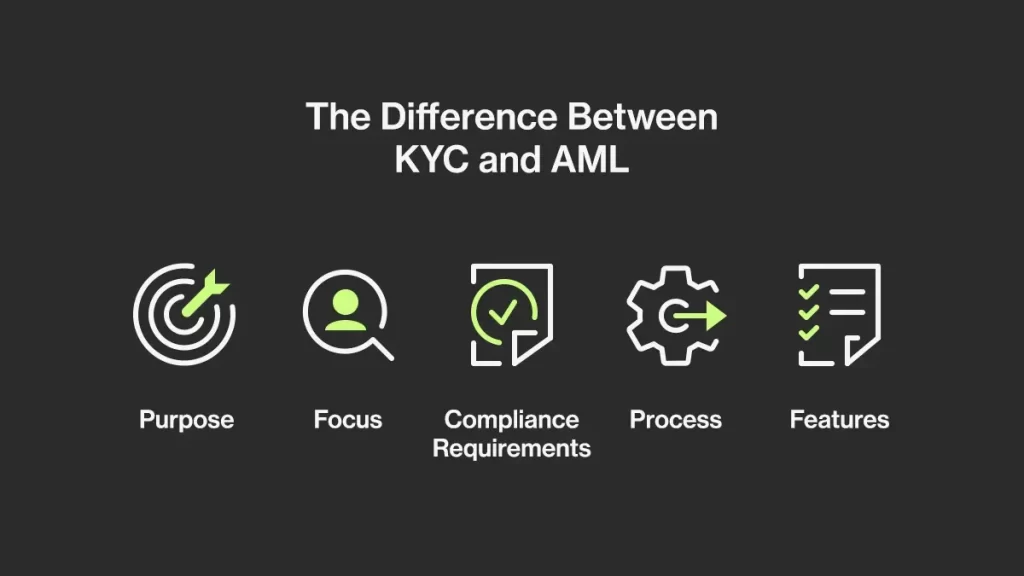KYC (Know Your Customer) and AML (Anti-Money Laundering) play pivotal roles in safeguarding institutions and businesses from financial crimes. While they share a common goal of preventing illicit activities, the differences between KYC and AML are crucial for establishing a robust regulatory framework.
What is KYC?
KYC stands for Know Your Customer. It is a process that businesses and financial institutions use to verify and authenticate the identity of their customers. The main purpose of KYC is to ensure that the individuals or entities involved in a business relationship are accurately identified and can be trusted.
KYC procedures typically involve collecting and verifying various types of customer information, including:
- Identity Information: This may include a customer’s full name, date of birth, address, and government-issued identification documents (such as a passport or driver’s license).
- Contact Information: Email addresses, phone numbers, and other relevant contact details.
- Occupation and Source of Income: Information about a customer’s occupation, employer, and the source of their income.
- Risk Assessment: Evaluating the level of risk associated with a particular customer based on their financial activities, transaction history, and other relevant factors.
The specific requirements may vary based on regulatory standards, industry practices, and the risk profile of the customer. KYC processes are essential for AML compliance and help businesses prevent fraud, money laundering, and other financial crime.
In general, KYC processes are focused on confirming a client’s identity by gathering identity document data and verifying it belongs to the person attempting to become a client of a business or service.
What is AML?
AML stands for Anti-Money Laundering. It is a set of regulations, policies, and procedures designed to prevent and detect the illegal practice of laundering money, which involves disguising the origins of funds obtained through criminal activities. The primary goal of AML measures is to deter and identify activities associated with money laundering and other financial crimes, including terrorist financing.
The essential information required by AML regulations includes:
Customer Identification Information (KYC):
- Full legal name
- Date of birth
- Residential address
- Government-issued identification (passport, national ID, driver’s license)
- Contact information (phone numbers, email addresses)
Customer Due Diligence (CDD):
- Occupation and employment details
- Source of income
- Business relationships and ownership structures
- Beneficial ownership information
- Nature and purpose of the business relationship
Transaction Monitoring:
- Monitoring and analyzing customer transactions for unusual or suspicious activity
- Establishing transaction thresholds and monitoring transactions that exceed these thresholds
Risk Assessment:
- Evaluating the risk associated with each customer based on their profile and transactions
- Determining the level of due diligence required based on the assessed risk
Politically Exposed Persons (PEP) Screening:
- Identifying whether customers are politically exposed persons or have close associations with them
Sanctions Screening:
- Checking customer names against national and international sanctions lists to ensure compliance with sanctions regulations
Record-keeping:
- Maintaining accurate and up-to-date records of customer information, transactions, and AML activities
Suspicious Activity Reporting (SAR):
- Reporting any identified unusual or suspicious activities to the relevant authorities as required by law
As with KYC, the specific requirements may vary based on the jurisdiction, industry, and the nature of the business.
The Difference Between KYC and AML

In a nutshell, KYC is a part of AML compliance and focuses on a specific part of the process, while AML regulations include a broader set of requirements.
Purpose:
KYC is about identity verification and establishing the legitimacy of customers. It ensures that the person on the other end of a financial transaction is who they claim to be. On the flip side, AML is a broader initiative aimed at detecting and preventing illicit activities, particularly money laundering and other financial crimes.
Focus:
KYC is customer-centric, focusing on gathering and verifying customer information. It’s the initial step in building a relationship between a business and its clients. AML, on the other hand, broadens its focus beyond individual customers to scrutinize financial transactions for any signs of suspicious activity. While KYC is a prerequisite for AML, they address different aspects.
Compliance Requirements:
KYC and AML are intertwined, but they have distinct compliance requirements. KYC compliance involves collecting and validating customer data to meet regulatory standards. AML compliance, however, encompasses a wider range of obligations, including risk assessment, transaction monitoring, and reporting unusual activities.
Process:
The KYC process involves customer identification, document verification, and maintaining up-to-date customer information. AML, on the other hand, incorporates ongoing monitoring, analysis of transaction patterns, and reporting of any anomalies. While KYC is a point-in-time process, AML is a continuous effort to ensure the legitimacy of financial activities.
Features:
KYC acts as a gateway, ensuring that only legitimate customers enter the financial system. It involves gathering basic information. AML, being more comprehensive, focuses on the source of funds, transactional behaviour, Sanctioned status and other data markers to identify and prevent financial crimes.
What are the Benefits of KYC and AML Processes?
Businesses should implement KYC and AML processes for several important reasons:
- Regulatory Compliance: Many jurisdictions require businesses, especially those in the financial sector, to comply with KYC and AML regulations. Failing to implement these processes can lead to legal consequences, including fines and sanctions.
- Preventing Money Laundering: AML processes are designed to detect and prevent money laundering, a process by which illegally obtained funds are made to appear legitimate. Preventing money laundering helps maintain the integrity of financial systems and disrupts criminal activities.
- Protecting Reputation: Implementing robust AML processes helps protect a business’s reputation. Being associated with money laundering or financial crimes can lead to severe reputational damage, loss of trust from customers, and a decline in business relationships.
- Risk Mitigation: AML processes include risk assessments that help businesses evaluate the risk associated with specific customers, transactions, or business relationships. This risk mitigation strategy is essential for preventing financial losses and reputational damage.
- Enhancing Financial System Stability: AML processes contribute to the overall stability of the financial system by preventing the injection of illicit funds. This stability is essential for economic growth and the well-being of society.
- Customer Trust and Confidence: AML processes help build and maintain customer trust and confidence. Customers are more likely to engage with businesses that prioritize the security of their financial transactions and demonstrate a commitment to preventing financial crimes.
How can Ondato Help?
Although essential, KYC and AML regulations can be tricky to implement. From the resources needed to gather all required data to ensuring the process is still convenient for customers, many companies have turned to Ondato’s automated solutions for AML and KYC checks.
Ondato’s KYC includes identity verification solutions that can be completed in 60 seconds, are able to verify over 10 000 document templates, check with global databases and provide 99.8% accuracy.
We also offer a centralized hub that helps companies adhere to even the strictest AML regulations. This includes PEP, Sanctions and reputational risk media checks, customer due diligence processes as well as transaction monitoring solutions with the help of our partners.
Last Thoughts
In essence, while KYC and AML work hand-in-hand to create a secure financial environment, they serve distinct purposes. KYC lays the foundation by verifying the identity of customers, while AML takes a broader approach, safeguarding against money laundering and other financial crimes. Understanding the differences between KYC and AML is not only crucial for compliance but also for building a resilient and trustworthy financial ecosystem. As financial landscapes continue to evolve, so too must our comprehension of these essential components that fortify the foundations of the financial world.



